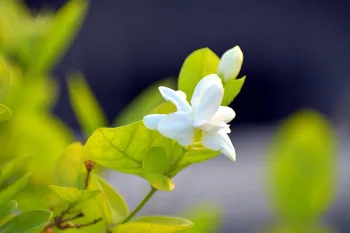Blog by Michelle Krespi
I was scrolling Etsy looking for something entirely different when I came across a sale on Sambac Arabian Jasmine or Jasminium sambac, which was advertised as both fragrant AND low- maintenance. Always a sucker for fragrant plants I was intrigued. It was heralded as “one of the Best bush Jasmine choices” and continued with, “has small snow-white flowers with an intoxicating fragrance!” How could I resist? Once I moved to Solano County from Oakland, where the winters are so much colder, I grew Gardenia plants every place I lived. True confession- not realizing how much stronger the sun was here, I burnt my first gardenia, causing it to take a full year to recover and flower! I was not going to make that mistake again. This next line in the ad sealed the deal: “brings a great garden feel to the indoors!” I now have that amazing scent in my bedroom. A little slice of plant heaven![1]

During my research, I learned that this Jasmine is a well-traveled plant. Sambac Arabian, while being a native to India and Bhutan, is cultivated in exotic places like Madagascar, the Maldives, Mauritius, Christmas Island, Central America, Chiapas, the Bahamas, Cuba, Puerto Rico, Jamaica, the Lesser Antilles, and finally southern Florida! My question after learning this was, why then was this plant named Arabian Jasmine? It is because the plant was widely cultivated in the Arabian Peninsula.[2] What is so appealing about this plant is that it blooms all year round in clusters of 3-12 blossoms together at the end of a branch. The flowers open in the evening ,spreading their scent usually between the hours of 6-8 pm and close in the morning with a 12–20-hour span! I can attest to the fact that they have a lovely floral fragrance![3] In fact the flowers are used commercially for perfumes and teas.
The genus Jasminium contains between 217-229 species of shrubs and vines, with the most popular ones being: Maid of Orleans, Belle of India, Arabian Nights, Grand Duke of Tuscany, and Mysore Mallige.[4] It was first described in 1753 by the famous Swedish botanist Carl Linnaeus (the father of binomial nomenclature, the modern system of naming organisms[5], and one of the founders of modern ecology). Sambac is the national flower of the Philippines, where it is named Sampaguita. It is also the national flower of Indonesia, where the people named it Melati Putih.
In terms of growing this indoor version of Jasmine, it can take full sun combined with some shade. Be careful when you introduce the plant to full sun, though. Fortunately, this plant will give you feedback. Too much intense direct light can scorch the leaves, while too little will cause the plant to become too leggy as it stretches for light. It does not tolerate frosty conditions or too much moisture. If planted in a container, be careful of your container size. This plant is unhappy if put into an oversized pot, so look for a container that is 2”-3” bigger than the prior one. Once reported, make sure the container has adequate drainage. It prefers a soil mix with a combo of organic and inorganic components like peat moss, compost, perlite, and vermiculite. It is like a slightly acidic soil mix, which can be accomplished by adding Sphagnum Moss into your recipe.
Another thing to watch is your watering. Did you know the most common cause of death to plants is overwatering? To avoid this, water your Jasmine thoroughly and allow it to dry out in between waterings. During the growing season, fertilize your plant with a balanced fertilizer every two weeks.
The last two aspects of care I would like to mention are propagation and pest control. The best method is through stem cuttings. Take a 6” cutting from a healthy stem, cutting the stem on a 45-degree angle, and dip the end in rooting hormone. You are ready to plant in your soil mixture. Make sure the plant is in a warm, humid place until it develops roots.[6] One way to introduce humidity it to put enough pebbles in your saucer so that you can add water without making contact with the bottom of the plant, so the roots have humidity without becoming waterlogged.
If you are growing your plant in a container, you will need to replace the soil every two years. Your reward for all this care is an abundance of beautiful, fragrant blooms for years to come!
[1] Picture taken by author of her new Arabian Jasmine
[2] The Arabian peninsula consists of Bahrain, Kuwait, Oman, Qatar, Saudi Arabia, United Emirates, Yemen, Jordan, and Southern Iraq
[3] Wikipedia- Articles on Arabian Peninsula, Jasminium sambac
[4] Garden Beast
[5] Wikipedia- Carl Linnaeus
[6] From website Live to Plant, Arabian Jasmine Planting Guide: Tips and Tricks for Healthy Growth

